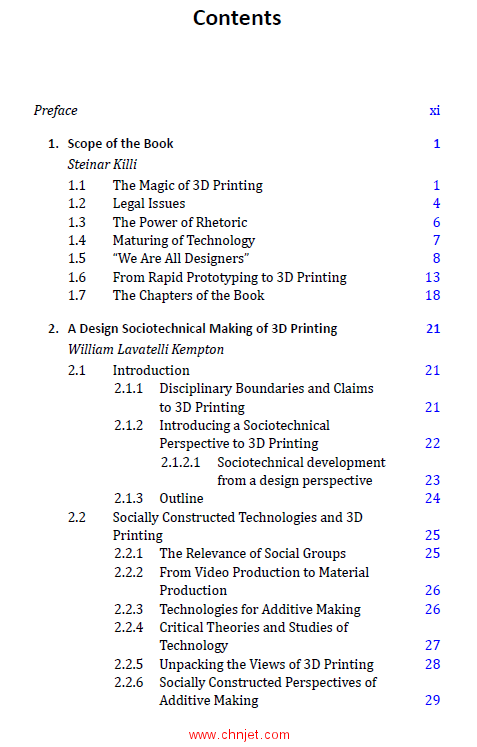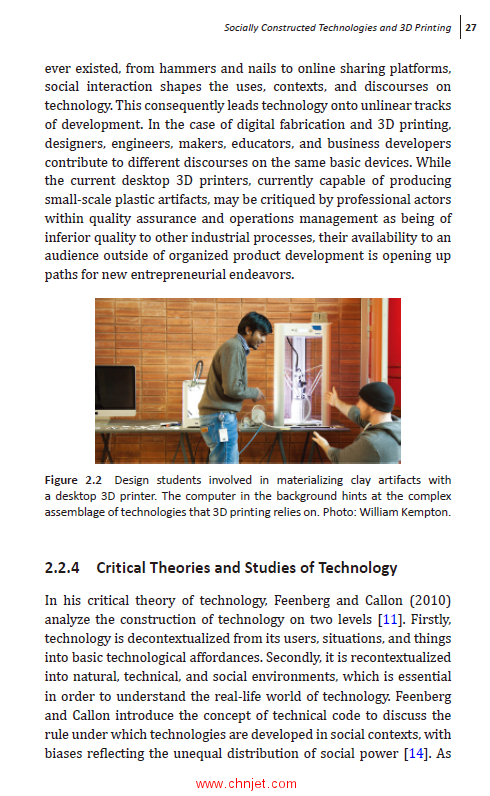马上注册,结交更多好友,享用更多功能,让你轻松玩转社区。
您需要 登录 才可以下载或查看,没有账号?立即注册

×
《Additive Manufacturing: Design, Methods, and Processes》
增材制造:设计、方法和过程
编者:
Steinar Killi
出版社:Pan Stanford
出版时间:2017年
《Additive Manufacturing: Design, Methods, and Processes》

《Additive Manufacturing: Design, Methods, and Processes》

《Additive Manufacturing: Design, Methods, and Processes》

《Additive Manufacturing: Design, Methods, and Processes》

目录
of 3D Printing 21
William Lavatelli Kempton
2.1 Introduction 21
2.1.1 Disciplinary Boundaries and Claims
to 3D Printing 21
2.1.2 Introducing a Sociotechnical
Perspective to 3D Printing 22
2.1.2.1 Sociotechnical development
from a design perspective 23
2.1.3 Outline 24
2.2 Socially Constructed Technologies and 3D
Printing 25
2.2.1 The Relevance of Social Groups 25
2.2.2 From Video Production to Material
Production 26
2.2.3 Technologies for Additive Making 26
2.2.4 Critical Theories and Studies of
Technology 27
2.2.5 Unpacking the Views of 3D Printing 28
2.2.6 Socially Constructed Perspectives of
Additive Making 29
2.2.7 Relevant Social Groups as Part of a
Technological Frame 30
2.3 The 3D Printer Inventors 31
2.3.1 The First Wave of 3D Printer Inventors 32
2.3.2 The Second Wave of 3D Printer Inventors 34
2.4 Business Perspective of 3D Printing 36
2.4.1 Yet Another Industrial Revolution 36
2.4.2 Toward Economies-of-One 37
2.5 Designers’ Perspectives of 3D Printing Futures 40
2.5.1 Design and Additive Manufacturing 41
2.5.2 Designing with Technology 42
2.5.3 An Undetermined View of Design 43
2.6 A Layperson’s Perspective of 3D Printing Futures 44
2.6.1 A Layperson as a Maker 45
2.6.2 Making in a Learning Environment 46
2.7 Discussions and Conclusions 48
2.7.1 Summarizing the Perspectives 48
2.7.2 3D Printing Futures 48
2.7.3 Constructing a View of Sociotechnical
Development 49
Appendix: Technologies for 3D Printing 50
3. AICE: An Approach to Designing for Additive
Manufacturing 75
Steinar Killi
3.1 AICE: An Operational Model 81
3.1.1 Adapt 81
3.1.1.1 Design thinking 81
3.1.1.2 Multitypes 84
3.1.1.3 Models describing a typical
design process 85
3.1.1.4 Methods used during a design
process 89
3.1.2 Integrate 98
3.1.3 Compensate 100
3.1.3.1 Spare parts 102
3.1.3.2 Production aids 103
3.1.3.3 Enhancing the design 103
3.1.4 Elongate 106
3.2 Using the AICE Model and How the Drinking
Container Came Out 109
4. The Impact of Making: Investigating the Role of the
3D Printer in Design Prototyping 111
William Lavatelli Kempton
4.1 Introduction 111
4.1.1 Prototyping as Design Development 111
4.1.2 Making as a Critical Practice 112
4.1.3 Outline 113
4.1.4 Methods 114
4.2 Background 115
4.2.1 From Rapid Prototyping to Additive
Manufacturing 115
4.2.2 Ubiquity and Stratification of 3D
Printing 117
4.2.3 Contexts for Additive Making 118
4.2.4 Hybrid Artifacts 120
4.2.5 Making Representations as a Way
of Designing 121
4.3 Prototypes and Design Representations 121
4.4 The Changing Character of Design 123
4.4.1 New Product Development 123
4.5 Situating AM Prototypes within Design
Practice 125
4.5.1 Developmental Prototypes 125
4.5.2 Initial Concept and Maturation of
the SunBell Lamp 126
4.6 Design Representations and Multitypes
in Product Design 129
4.6.1 Multitypes in Rapid Prototyping 131
4.7 Multityping in Additive Manufacturing 134
4.7.1 Popular yet Professional? 134
4.7.2 Integrating AM in Product Design 135
4.7.3 Toward the Releasetype 136
4.8 Conclusions 137
5. Visual 3D Form in the Context of Additive Manufacturing 143
Nina Bjørnstad and Andrew Morrison
5.1 Introduction 143
5.2 Aesthetics 144
5.3 Design, Action, and Profession 147
5.4 Ideals and Origin 148
5.5 Relevance of the Historic Model for
Tomorrow’s Form Givers 149
5.6 The Evolution of Form Model 150
5.6.1 Why Clay? 151
5.6.2 A Close-Up on Form 153
5.6.3 Distorted Forms 155
5.6.4 Intersectional Forms 157
5.7 Familiarity 160
6. Potential of Additive-Manufactured Products in
Building Brands 165
Monika Hestad and Viktor Hiort af Ornäs
6.1 Product Role in Brand Building 168
6.1.1 Role of Design Elements in Building
a Brand 168
6.1.2 Brand Story and Product Story 169
6.2 Additive Manufacturing as One of Many Other
Drivers That Affect a Product’s Role in
Building Brands 171
6.2.1 Actual and Intended User Experience 171
6.2.2 Internal Drivers 173
6.2.3 External Drivers 174
6.3 How Additive Manufacturing Is Used in
Building a Brand 175
6.3.1 Mykita 177
6.3.1.1 How AM is used in the
products 179
6.3.1.2 Design elements 179
6.3.1.3 User experience 179
6.3.1.4 Drivers 180
6.3.1.5 The Mykita brand story 182
6.3.2 pq Eyewear by Ron Arad 184
6.3.2.1 How AM is used in the
products and in branding 186
6.3.2.2 Design elements 186
6.3.2.3 User experience 188
6.3.2.4 Drivers 189
6.3.2.5 The pq eyewear brand story 190
6.4 Potential of Additive-Manufactured Products
in Building a Brand 191
6.4.1 How They Used AM in Building a Brand 191
6.4.2 Opportunities in New Production
Techniques 193
6.4.3 Form Freedom and Brand Development 194
6.4.4 Potential of Disruptive Stories 195
7. A Tale of an Axe, a Spade, and a Walnut:
Investigating Additive Manufacturing and Design
Futures 199
Andrew Morrison
7.1 Prelude 199
7.2 Queries 201
7.2.1 On Discursive Design 203
7.3 “Problems” 205
7.3.1 Design, Narrative, Futures 205
7.4 Essayistic 206
7.4.1 Narrative 208
7.5 Promotion 210
7.5.1 Intersections 213
7.6 Foresight 214
7.6.1 Scenarios and Futures 216
7.6.2 The Fictive and Nondeterminist
Futures 217
7.7 Reflections 218
7.7.1 Toward the Additive in Discursive
Design 220
7.7.2 Design Baroque Futures 220
7.8 Generative Visions 222
Index 231
专业书籍
下载地址:(回复后可见)
| ![]()